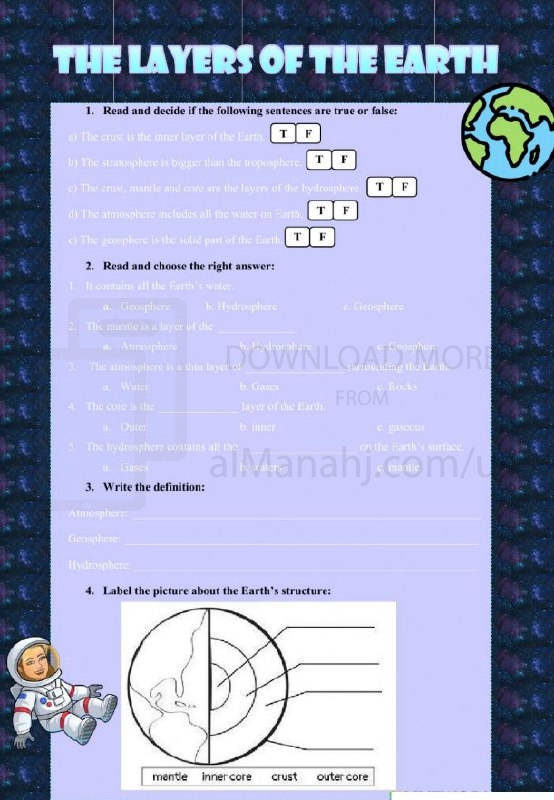| You are here: Almanahj Website ⇒ American curriculum ⇒ 5th Grade ⇒ Geology ⇒ Term 1 | ||
|---|---|---|
Worksheet about Geosphere and Atmosphere and Hydrosphere | ||
|---|---|---|
| Subject: Geology | ||
| 5th Grade | ||
| Term 1 | ||
| Year: 2023/2024 | ||
| Size: 484.9KB | ||
| Number of clicks: 134 | ||
| Publish date:November 23, 2023 | ||
| Added by: Eman | ||
| Last download date: 2024-09-12 00:27:58 | By: theodor mlainez | |
| File info: The Earth is a complex and dynamic system made up of four interconnected spheres: the geosphere, atmosphere, hydrosphere, and biosphere. These spheres interact with each other in a way that sustains life on Earth. Geosphere The geosphere is the solid, non-living part of the Earth. It includes the Earth's crust, mantle, and core. The crust is the outermost layer of the Earth, and it is made up of rock and soil. The mantle is the layer of rock beneath the crust, and it is made up of hot, molten rock. The core is the center of the Earth, and it is made up of iron and nickel. The geosphere is constantly changing, thanks to plate tectonics. Plate tectonics is the movement of the Earth's tectonic plates, which are large, slowly moving pieces of the Earth's crust. Plate tectonics creates mountains, volcanoes, and earthquakes. Atmosphere The atmosphere is the layer of gases that surrounds the Earth. It is made up of nitrogen, oxygen, argon, carbon dioxide, and other gases. The atmosphere protects the Earth from harmful ultraviolet radiation from the Sun, and it helps to regulate the Earth's temperature. The atmosphere is constantly changing, thanks to weather and climate. Weather is the day-to-day conditions of the atmosphere, such as temperature, humidity, and precipitation. Climate is the average weather conditions over a long period of time. Hydrosphere The hydrosphere is the water that covers the Earth. It includes the oceans, lakes, rivers, and groundwater. Water is essential for life, and it plays a vital role in the Earth's climate system. The hydrosphere is constantly changing, thanks to the water cycle. The water cycle is the continuous movement of water between the Earth's surface and the atmosphere. Water evaporates from the Earth's surface, condenses into clouds, and then falls back to the Earth as rain or snow. Biosphere The biosphere is all of the living organisms on Earth. It includes plants, animals, fungi, bacteria, and other organisms. The biosphere is dependent on the other spheres for survival. The biosphere is constantly changing, thanks to evolution. Evolution is the process by which organisms adapt to their environment over time. Evolution has led to the diversity of life on Earth that we see today. Interactions of the Spheres The four spheres of the Earth are not isolated from each other. They interact with each other in a way that sustains life on Earth. For example, the atmosphere interacts with the geosphere by weathering rocks and soil. The hydrosphere interacts with the geosphere by eroding rocks and forming landforms. The biosphere interacts with the atmosphere by producing oxygen and carbon dioxide. The interactions of the spheres are complex and dynamic, and they are constantly changing. Understanding these interactions is essential for managing the Earth's resources and protecting the environment. | ||
| Downloading link Worksheet about Geosphere and Atmosphere and Hydrosphere |
|---|
|
1700753890.pdf
The file is being prepared for download
|
| File images |
|---|
 |